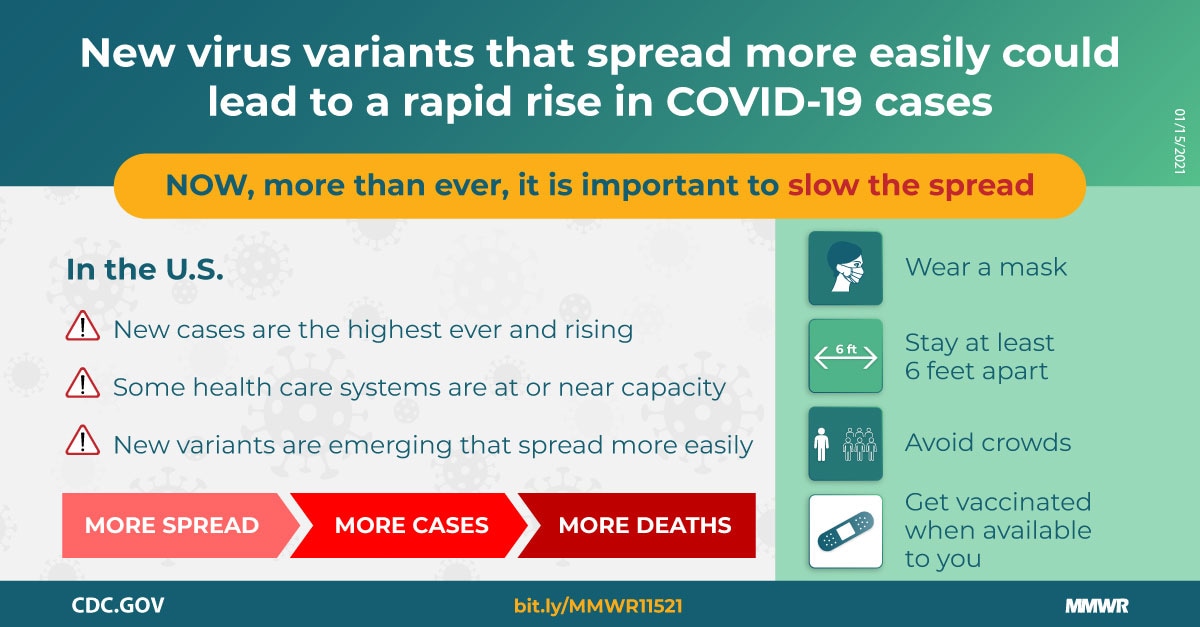Early Release / January 15, 2021 / 70
Summer E. Galloway, PhD1; Prabasaj Paul, PhD1; Duncan R. MacCannell, PhD2; Michael A. Johansson, PhD1; John T. Brooks, MD1; Adam MacNeil, PhD1; Rachel B. Slayton, PhD1; Suxiang Tong, PhD1; Benjamin J. Silk, PhD1; Gregory L. Armstrong, MD2; Matthew Biggerstaff, ScD1; Vivien G. Dugan, PhD1
Summary
What is already known about this topic?
A more highly transmissible variant of SARS-CoV-2, B.1.1.7, has been detected in 10 U.S. states.
What is added by this report?
Modeling data indicate that B.1.1.7 has the potential to increase the U.S. pandemic trajectory in the coming months. CDC’s system for genomic surveillance and the effort to expand sequencing will increase the availability of timely U.S. genomic surveillance data.
What are the implications for public health practice?
The increased transmissibility of the B.1.1.7 variant warrants universal and increased compliance with mitigation strategies, including distancing and masking. Higher vaccination coverage might need to be achieved to protect the public. Genomic sequence analysis through the National SARS-CoV-2 Strain Surveillance program will enable a targeted approach to identifying variants of concern in the United States.
... Multiple lines of evidence indicate that B.1.1.7 is more efficiently transmitted than are other SARS-CoV-2 variants (1–3). The modeled trajectory of this variant in the U.S. exhibits rapid growth in early 2021, becoming the predominant variant in March.
https://www.cdc.gov/mmwr/volumes/70/...cid=mm7003e2_w
Summer E. Galloway, PhD1; Prabasaj Paul, PhD1; Duncan R. MacCannell, PhD2; Michael A. Johansson, PhD1; John T. Brooks, MD1; Adam MacNeil, PhD1; Rachel B. Slayton, PhD1; Suxiang Tong, PhD1; Benjamin J. Silk, PhD1; Gregory L. Armstrong, MD2; Matthew Biggerstaff, ScD1; Vivien G. Dugan, PhD1
Summary
What is already known about this topic?
A more highly transmissible variant of SARS-CoV-2, B.1.1.7, has been detected in 10 U.S. states.
What is added by this report?
Modeling data indicate that B.1.1.7 has the potential to increase the U.S. pandemic trajectory in the coming months. CDC’s system for genomic surveillance and the effort to expand sequencing will increase the availability of timely U.S. genomic surveillance data.
What are the implications for public health practice?
The increased transmissibility of the B.1.1.7 variant warrants universal and increased compliance with mitigation strategies, including distancing and masking. Higher vaccination coverage might need to be achieved to protect the public. Genomic sequence analysis through the National SARS-CoV-2 Strain Surveillance program will enable a targeted approach to identifying variants of concern in the United States.
... Multiple lines of evidence indicate that B.1.1.7 is more efficiently transmitted than are other SARS-CoV-2 variants (1–3). The modeled trajectory of this variant in the U.S. exhibits rapid growth in early 2021, becoming the predominant variant in March.
https://www.cdc.gov/mmwr/volumes/70/...cid=mm7003e2_w

Comment